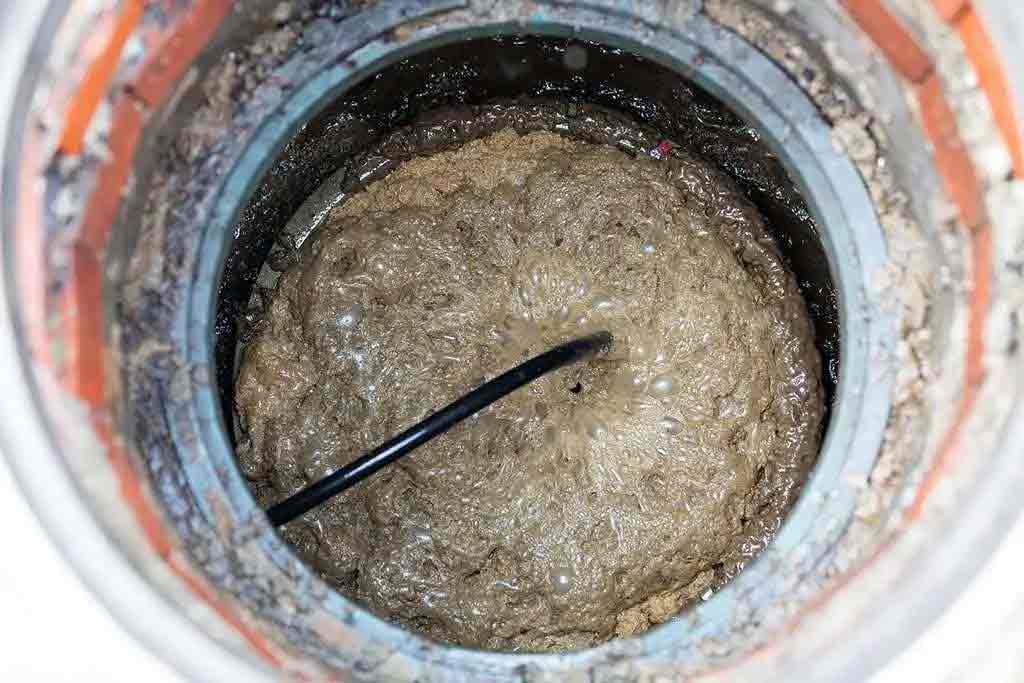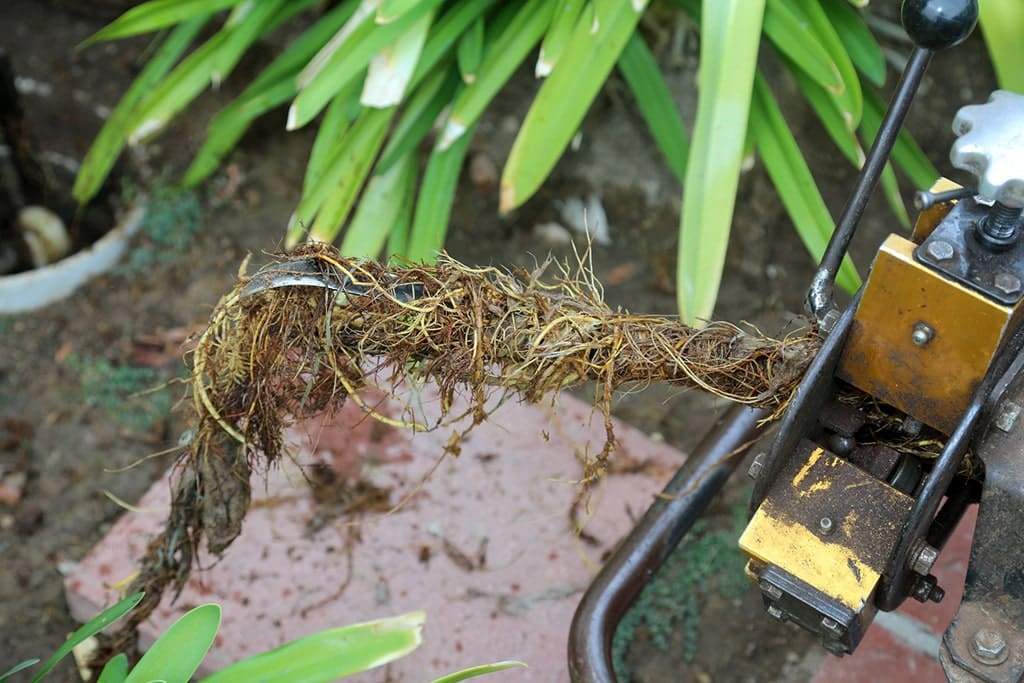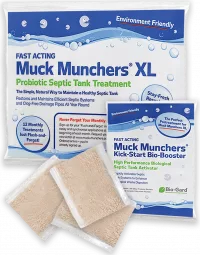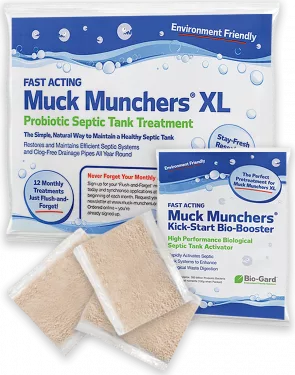What to do with a Clogged Septic Tank Drain Pipe?
A clogged septic tank drain pipe can slow down discharges and even cause serious damage. The key to preventing a septic tank drain pipe from blocking up is simply to take good care of your septic system.
A clogged septic tank drain pipe can occur for a variety of reasons, which is why it’s important to be prepared with a cure as much as preventative measures!

How Do Clogged Septic Tank Drain Pipes Occur?
The prime culprits behind a clogged septic tank drain pipe blockage is most likely to be FOGs – fats, oils and grease. This type of waste, when left to drain freely into a septic tank, can lead to systems backing up internal drains – as the FOGs can solidify and create a crust on top of the effluent waste held inside the tank itself.
Crucially, drains connected to a septic tank will block up and back up if your system is reaching its wastewater capacity. With a little bit of care (and with regular bacterial top-ups such as Muck Munchers), you can avoid such a scenario occurring.
Bacteria are a Key Weapon to a Clogged Septic Tank Drain Pipe!
The helpful bacterial microbes that live in your septic tank will feed on the organic waste you flush through your drains and toilets. Without these bacteria you would effectively be draining waste straight to a stagnant tank, ready to fill endlessly with effluent and zero waste digestion. Using the enzymes they produce, bacteria break down organic waste and sludge, allowing purer treated water to safely drain into the local environment through your soakaway.
If the bacteria die off or deplete, your wastewater and sludge levels are going to continue building up. That can lead to drains backing up inside the house and soakaways failing. Bacteria are extremely sensitive and can be killed off if exposed to excessive bleaches and chemical cleaners – meaning it’s always best to avoid flushing anything bar the three Ps – pee, poop and paper. This way, you can be sure your drains stay flowing freely.
Septic Tank Inlet Clogged?
In some cases, you may find a clogged septic tank drain pipe can occur if there are problems with your tank baffle or dip pipe (the pipe bend at the septic tank drain entrance), if you’re using your septic system more often than usual, are not regularly adding a bacterial septic tank treatment, or if you’re not emptying it when sludge levels are excessive.
In other cases, you may find that damage to your tank, or its soakaway, may result in wastewater and sludge backing up. For example, if a tree grows up through your soakaway and into your septic tank, it may result in your system backing up and not operating as it should.
In these extreme cases, you’ll need to call in a professional for help. Otherwise, it’s important to be vigilant about what you flush, and how you flush it.
Why You Shouldn’t use Chemical Drain Cleaners for a Septic Tank Clogged Pipe
It’s natural that you will want to clean your drains at some point – however, chemical-based solutions will almost certainly kill or deplete your tank’s bacteria population. No matter how efficient a chemical drain cleaner may be at cutting through backed-up waste and solid matter, it will also destroy the microbes that help to keep waste levels as low as possible.
It’s therefore recommended to use an enzyme drain cleaner in the event of running a septic tank. Products such as Digesta, for example, help to cut through partial septic tank blockages and keep your pipes and drains clean and clear. Developed specifically to keep bacteria in your septic tank healthy and fighting fit, this is an ideal solution if you wish to keep expensive pump-outs at bay.
Avoiding chemicals and switching to biological cleaners is only solving half of this common problem. As mentioned, it’s important to have a preventative measure, as well as a solution, when coming up against septic tank drain blockages. Use Digesta regularly, and you’ll avoid clogging as far as physically possible – but it’s still worth knowing how to deal with a clogged septic tank drain pipe.
How to Unclog a Septic Tank Drain Pipe
One of the quickest ways to unblock a clogged septic tank drain pipe or outlet is to create a safe formula you can use instead of a chemical cleaning solution. For example, many experts suggest using hot (but not boiling) water to cut through FOGs and relieve clogged septic tank drain pipe. Boiling water can potentially pose problems for your pipes’ integrity further down the line, though some recommend using such a method. This is always to be avoided if your sinks/pipes are built with porcelain and/or PVC.
The Natural Way to Unclog a Septic Tank Drain Pipe
A safer way to unblock a clogged septic tank drain pipe to a septic tank is to mix together white vinegar and baking soda. A popular homemade cleaning solution, this combination also works well as a drain unclogger. Mixing these household products together will create a carbonic, septic tank-safe solution that loosens up deep clogs and blockages. You’ll need to create a solution that’s around two parts baking soda to one part white vinegar. After 30 minutes, simply flush your drain with warm water, which should start to loosen up the clog deeper down the line.
Beyond this, you may need to remove the clogged septic tank drain pipe by hand. This can be a sensitive procedure, so if you’re unsure about opening up your septic tank and tackling the problem yourself, it may be a good idea to speak to a professional. Of course, this is only going to create cost – the best prevention from clogged drains is through regular care and maintenance.

How to Manually Unclog a Septic Tank Drain Pipe Yourself
Start by opening up your septic tank and probing into the inlet pipe to move clogged waste down further into the system.
You can either do this with a long pole or dipstick, or you may even be able to use an auger to work the blockage out. Of course, this plan of action will only be effective in certain blockage scenarios. An old fashioned, rubber-based plunger is also a great tool to keep to hand.
You may need to consider checking your toilet drain (or u-bend) if it is specifically your toilet that is blocking up. Check all of the other drains in your home (from sinks to showers) – there may not be an immediate need for you to open up the septic tank at all. Beyond this, broken or damaged soakaway outlets can cause major blockages and flow problems, meaning you may need to consult with a septic tank technician if you’re out of fresh options.
WARNING – If you undertake any work on your septic tank, never enter the tank and take extreme care not to be overcome by potentially toxic gases.
When it Comes to Clogged Septic Tank Drain Pipes – Prevention is Better Than Cause
While it’s important to know how to unblock a clogged septic tank drain pipe, it’s better to prevent your tank from blocking up in the first place. You may need to consider setting up a waste trap, for example, that can help to drain FOGs away from the main system, and therefore prevent any nuisance blockages further down the line.
How to Maintain Your Septic Tank Drains and Pipes
Maintaining your septic tank – and to avoid having to invest in a drain unblocker for septic tanks at all – is as simple as watching what you flush. Sticking to the ‘three Ps’ as much as possible will ensure that the bacteria in your tank remain healthy and active.
Avoid Flushing Any Items that Could Cause Immediate Blockages
Such as nappies, wet wipes and hygiene products – all of which many people commonly dispose of via their toilets. Septic tank clogged drains commonly block. thanks to inappropriate disposal.
Avoid Using Chemicals Wherever Possible
Keep your tank bacteria topped up with Muck Munchers – and your septic tank levels will be maintained at a stable rate, allowing you to continue using household drains with confidence.
Consider Installing a Waste Trap
Waste traps are great for taking heavy FOGs out of the equation. However, many of these options are best reserved for heavy-duty fat drainage – they are commonly used in restaurant kitchens, for example.
Be Aware of the Amount of Water You are Flushing Through Your Septic System
And be careful with how often you flush water through your drains. Increased usage of water drainage over a short space of time can result in your septic tank and soakaway becoming overwhelmed – resulting in slow draining further down the line.
To counteract this, be careful with how often you run water-intensive appliances, such as washing machines and dishwashers. Try and restrict using these systems during periods when no other water is draining. If someone is using the shower at the same time as the washer is in the middle of a cycle, it effectively means your septic tank has to deal with double the water.
Maintaining your septic tank drains and pipes will also help to reduce costs in the long term. Failure to keep on top of clogs and to use your drains inappropriately could lead to costly pumping call-outs.
The Best Way to Keep Your Drains Clear
The number one best way to keep your drains clear from clogs and blockages is, of course, to use regular treatments of Muck Munchers – and to choose a biological septic tank drain pipe cleaner – so you can ensure there’s always bacteria on side to reduce sludge and waste levels whenever they may arise.
Using Muck Munchers regularly will ensure that, regardless of what happens to your tank, you always have a healthy population of microbes ready to eat through and break down waste that could be causing blockages further down the line. While adding microbes to your septic tank may not instantly remove clogs, or burn through existing blockages, topping up will ensure that the chances of future clogging are greatly reduced.
Septic Tank Friendly Drain Unblocker
Beyond adding bacteria to your tank, it’s good practice to choose a septic tank waste pipe cleaner that’s free from corrosive chemicals and compounds. While the alternative may cut through waste efficiently, certain cleaners will reduce your tank bacteria and may even damage your pipe interiors.
Thankfully, Muck Munchers provides more than just microbes. Digesta, as already mentioned, is a fantastic septic tank-friendly waste trap and drain cleaner, great at preventing even the toughest of blockages.
In Summary
As many seasoned septic tank owners will tell you, keeping non-flushables clear of your toilet is the number one way to prevent a clogged septic tank drain pipe in. However, your pipes and drains may still become blocked occasionally by intensive water usage or through FOGs building up along the way.
Thankfully, there are plenty of preventive measures you can put in place to fight back against these common concerns. Start topping up with helpful probiotic bacteria and cut back on chemicals – and you’re already halfway to keeping future blockages at bay.










